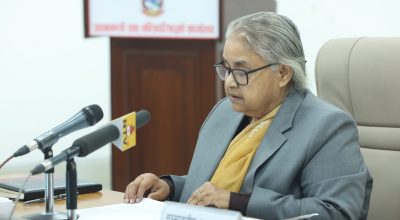
TOKYO – The gusto with which Japan has embraced rearmament has surprised its allies and international partners. Last month, Japanese Prime Minister Fumio Kishida unveiled detailed plans to double defense spending over the next five years, leaving no doubt about the country’s determination to expand its military capabilities to deter China’s expansionist ambitions.
Japan’s new strategic vision represents the culmination of a long-term shift that began under Kishida’s predecessor, Abe Shinzō, who was assassinated last July. During Abe’s tenure, which lasted from his return to power in December 2012 until his resignation in September 2020, Japan revamped its military doctrine and significantly increased defense expenditure. Abe also created a cabinet-level National Security Council, established the National Security Secretariat to support it, streamlined military procurement by forming the Acquisition, Technology & Logistics Agency (ATLA), and, last but not least, sought to amend Japan’s pacifist constitution, though in vain.
Taken together, Abe’s policies marked a historic shift in Japan’s defense policy and regional standing. No longer would Japanese security be a matter of wishful thinking, willful blindness, and dependence on the United States. Before Abe, if China had attacked a US warship near Japan’s territorial waters, the Japanese military would not have gotten involved. Abe rejected this absurd approach and pushed Japan to assume a central role in the Indo-Pacific. Now, if the US and China were to go to war over Taiwan, Japan could cooperate with the US military. In a role reversal of sorts, the Japanese military is now protecting US ships and planes in the region.
Kishida’s ambitious defense policies, which include increasing military spending to ¥43 trillion ($330 billion) by 2027 and revising Japan’s national security strategy to allow for counterstrike capabilities, implement many of Abe’s ideas. They also expand on them in four meaningful ways.
First, the new security doctrine calls a spade a spade. When Japan published its first-ever national security strategy in 2013, China’s incursions into Japanese waters and airspace near the Senkaku Islands were described as “an issue of concern to the international community, including Japan.” The revised strategy, however, refers to China – in line with US rhetoric – as “an unprecedented and the greatest strategic challenge” to Japan. As this change makes clear, Japan’s military build-up aims, first and foremost, to deter Chinese expansionism.
Second, the new strategy seeks to build up fuel and ammunition supplies, thereby addressing a problem that Abe repeatedly warned about. While Japan has purchased many fighter jets, ships, and combat vehicles over the past decade, it still lacks the strategic stockpiles and secure storage facilities needed to sustain a long war.
To be sure, stocking up on munitions and fuel is far less glamorous than purchasing F-35 fighter jets or long-range Tomahawk cruise missiles from the US. But while massive arms purchases will certainly help Japan face the triple threat of Russia, China, and North Korea, the truth is that its strategic position is far more precarious than that of any other G7 member. Unless it builds and maintains adequate strategic reserves, Japan will not be able to defend itself.
Third, the US-Japanese defense pact used to have an unwritten rule that all new military assets should be under the Americans’ control. Recently, however, Japan, the United Kingdom, and Italy announced a joint effort to develop a next-generation fighter jet. The US Department of Defense immediately put out a statement in support of the new partnership, reflecting the growing military cooperation between the US, Japan, European countries, Australia, and India.
Lastly, the revised national security strategy states that “Japan will actively accept displaced people due to war.” This allusion to a possible Chinese invasion of Taiwan, together with the implied willingness to accept the many Taiwanese citizens who would surely flee if that happened, did not attract much attention, but it is groundbreaking.
Had Abe lived, he would have been pleased that Kishida’s government is pursuing many of the goals he wanted to achieve. While the new national security agenda stops short of amending the existing restrictions on the deployment of offensive weapons, it does emphasize the need to develop counterstrike capabilities that would enable Japan to hit targets in other countries in the event of an attack.
But while the proposed increase in military spending seems to enjoy broad public support, the question of how to pay for it will most likely be the subject of fierce parliamentary debate. Kishida’s plan to fund the additional expenditures by raising taxes has already provoked strong opposition, even within his own party. Kishida’s competence will undoubtedly be put to the test over the coming months, as will Japan’s newfound strategic resolve.
Taniguchi Tomohiko, a professor at Keio University’s Graduate School of System Design and Management, is a former special adviser to Japanese Prime Minister Abe Shinzō.
Copyright: Project Syndicate, 2023.
www.project-syndicate.org
















